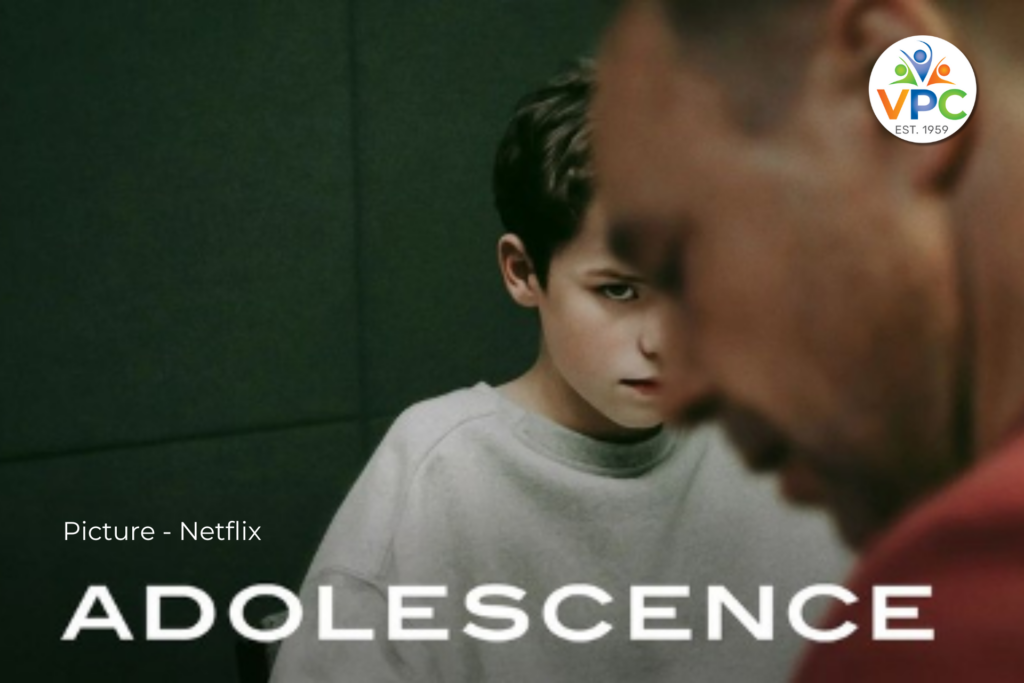
ADOLESCENCE – what do we take away from this series?
If you haven’t seen Adolescence, you might want to sit down and see what all the discussion is about. This four-part British series, released on Netflix on March 13, 2025, has quickly become one of the most talked-about shows in recent memory. The idea for the series came from its star, Stephen Graham, after a series of violent crimes in the UK, where adolescent boys attacked—and, in some cases, fatally stabbed—young girls. This disturbing reality led to a collaboration with screenwriter Jack Thorne, culminating in the creation of Adolescence.
Though rooted in UK crime statistics and experiences, the themes explored in Adolescence resonate globally. The series examines knife crime, cyberbullying, male rage, and the toxic influence of misogynistic messaging on social media—forces that shape the emotional and behavioral landscape of young boys today.
At its core, Adolescence follows a seemingly “normal” family. Through Eddie, the father, we witness a man grappling with a deeply ingrained struggle: his determination not to repeat the abusive behavior of his father. In episode four, Eddie recalls how his father, consumed by rage, would beat him. He swore he would never inflict the same pain on his son. However, despite his resolve, he wrestles with his own volatile anger, which manifests in destructive outbursts—though never directed at his children. This struggle is starkly evident when he confronts a teenager who vandalised his van. His fury escalates to an aggressive confrontation, stopping just short of physically assaulting the teen.
The series makes a crucial point: while Eddie has broken the cycle of physical abuse, the deep-seated rage passed down through generations still lingers. This inherited anger surfaces in Jamie, his son, culminating in an explosive scene in episode three, brought to life by the outstanding performances of Owen Cooper, who plays Jamie, and Erin Doherty, who portrays the interviewing psychologist. The show highlights how unresolved, poorly understood emotional turmoil can fester and infect future generations, becoming a dangerous force in the absence of healthy outlets.
What Adolescence underscores most chillingly is the role of technology in exacerbating this issue. Jamie, still too young to fully comprehend or process his emotions, finds his feelings manipulated and distorted through his smartphone and computer. The internet provides access to a dark world that preys on his vulnerability, steering him toward a path that, however troubling, provides a misguided sense of emotional resolution.
The final episode is gut-wrenching. We watch the parents, devastated, trying to comprehend the nightmare unfolding before them. They had believed they were good parents. They had tried. He was in his room—they thought he was safe. For generations, that assumption was valid: if your child was home, they were safe. But today, the internet and social media have made this assumption null and void.
In episode four, Eddie poses a haunting question to his wife, Mandy: “Could we have done more?” This is met with Mandy’s painful yet honest response: “I think it’d be good… if we accepted that maybe we should’ve done.”
In an interview, Graham explained that the aim of the show was not to assign blame but to prompt a deeper question: Why would a young boy take the life of a young girl? What is going wrong in our society that this is happening? He reminds us that it takes a village to raise a child—and that the entire village is accountable.
So, what can we as parents do differently?
For me, this is the heart of the issue: How do we engage with our children in a way that acknowledges their vastly different world without our own fears getting in the way? How do we help them understand their emotions and guide them toward healthy ways of coping, rather than allowing their confusion and pain to be exploited by harmful online influences? The answer lies in having ongoing conversations—not just with our teens, but with health professionals, educators, and other parents.
Here are some suggestions to help navigate these difficult conversations:
1. Have a clear ‘WHY’
Know why you are initiating the conversation. For example, “I want to make sure you are safe and that you are not being influenced negatively by the social media you see.”
2. Set the right environment
Pick a moment when they are more likely to respond. Choose a neutral, comfortable space. If possible, engage them during an activity (e.g., driving, walking, or cooking together) to make the conversation feel more natural. If you feel that neutral time never exists, then it may be necessary to try in short, sharp bursts. For example, you could say, “I am going to say a few difficult things for 2 minutes. You don’t have to answer straight away. I will come back later and try again.”
3. Do your homework
Understand the terms they encounter—what is toxic masculinity or the ‘manosphere’? Knowing about the games they play online can also provide insight into their behavior. Setting boundaries is okay.
4. Listen more, speak less
Approach with curiosity, not judgment. Give them space to express themselves without immediately offering solutions. Use active listening—nod, paraphrase what they’ve said, and validate their feelings.
5. Stay calm and regulate your emotions
Teens pick up on the ‘vibe’. There is nothing more alarming to a teenager than their alarmed parent. Practice your questions in front of a mirror and see what they will see. Notice your expression and tone of voice. Aim for an expression and tone that says, “I love you and want to help,” rather than, “I’m terrified, and I want this to stop now.” If things get tense, take a break and return to the conversation later.
6. Respect their perspective
Even if you disagree, acknowledge that their feelings and experiences are real. Saying “I hear you” or “That sounds hard” helps them feel understood. If they resist talking, reassure them that you are always available.
7. Offer guidance, not just rules
Teens need both guidance and the opportunity to develop critical thinking. Explaining the reasons behind rules rather than simply enforcing them helps them exercise their critical thinking.
8. Help them process their feelings
Let them know that feeling unsure or confused is normal when facing unfamiliar situations. You can connect by sharing that discussing this topic makes you feel uncertain too.
9. Check-in and repeat the process
Difficult conversations should not be one-time events. Keep the lines of communication open. Express appreciation: “I really appreciate you talking to me about this. I know it’s not easy.”
10. Know when to seek help
If you are worried about their mental health in any way, then seek professional help. The starting point may be you sitting down with your GP or a mental health professional and getting guidance from there.
Adolescence doesn’t try to provide easy answers to a complex problem. Instead, it forces us to confront an unsettling reality—one that demands thoughtful, proactive engagement. As parents, we are a significant part of our children’s inner support network. The world they are growing up in is different from the one we knew. Understanding their digital world is crucial. Social media and online spaces are not inherently bad, but they can be dangerous. Our role is not to shut them out but to equip our children with the emotional tools to navigate them safely.
Katrina Gow
Katrina is a compassionate and skilled counsellor dedicated to fostering mental health and resilience. In 2025, she will contribute her expertise as an advisor to a Deakin University project addressing school attendance issues, helping develop strategies for improving educational outcomes. Additionally, Katrina is part of the Victorian Parents Council team and writes insightful blogs for the VPC, offering support and guidance to parents navigating challenges in education and parenting. Through her work, she strives to create positive change in both individual lives and broader community settings.

